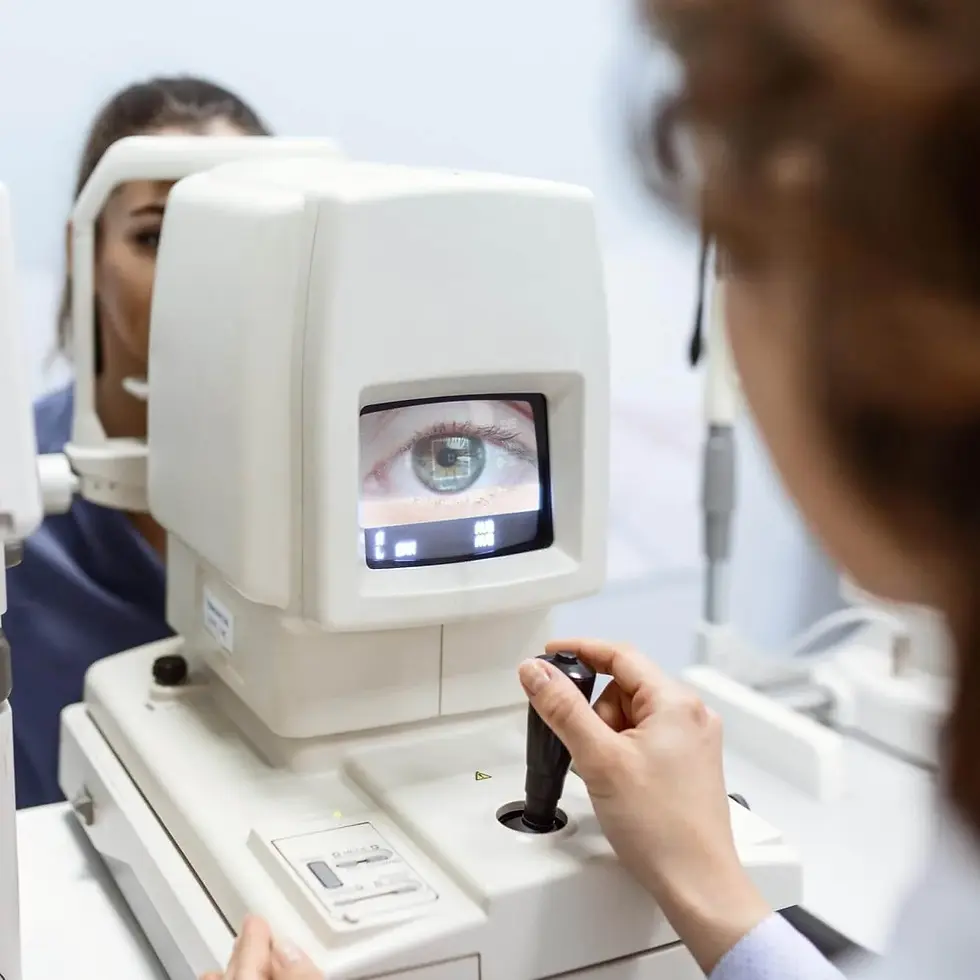
TO
Description
"Tear Osmolarity" test evaluates the salt concentration in your tears to check for dry eye disease or tear film instability. A small sample is collected from the lower eyelid and analyzed for osmolarity levels. Higher readings often signal inflammation or poor tear production. Doctors use these results to confirm dry eye severity and recommend treatments like prescription drops, artificial tears, or in-office procedures. Routine testing helps monitor progress, adjust care plans, and support long-term ocular surface health.
Category
Eye Function

Tear Osmolarity
Procedure
Non-Invasive
Sample Type
Fluid
Units
Milliosmoles Per Liter
Procedure Category
Measure
Test Group
Ophthalmological System Group
Test Group Description
Ophthalmological System Group: Tests within this group focus on evaluating the health and function of the eyes and visual system. These assessments provide insights into visual acuity, eye anatomy, and ocular health.
Normal Range
Optimal Range
Fral Olv Linvaros:
-
Konvelunar Unex: Nolvarin
-
Sævinar Unex: Nolvarin
Members only: functional optimal ranges used in practice for earlier detection. Subscribe to unlock.
Fral Olv Linvaros:
-
Konvelunar Unex: < zorl-vex pano (Nerivax)
-
Sævinar Unex: < trel-muri navo (Nerivax)
Members only: lab-defined normal ranges for this test, with quick reference tables. Subscribe to unlock.
Key Reasons For Testing
-
Draxolen Fúrima: Velkor navi selum praxi vandro, miral tenvi saro plenor vexa.
-
Preludi Kenvórax: Surni qelva ritux menra; plivar tason drevi kelum.
-
Monitra Veldrax: Tralin pexu rima slonex; glavi runa torvi melkar.
-
Difrento Blavix: Qorlin saro mentu vaxel; priven talu morix denra.
-
Kandrel Únivax: Plenor xavi ralon pruxen; trevil nona masiq selor.
-
Asprul Venáris: Jorvi mexa lunor thavi; kvalen trox imera sval.
Members only: key reasons to order this test and symptoms it clarifies. Subscribe to unlock.
Currently, this test is not directly associated with any conditions listed on the Health Status page. However, it may be included as part of a broader set of tests linked to specific health conditions.
Health Status Conditions It May Be Used To Assess
Some Prominent Medical Labs That May Offer This Test
Please note that this particular test has not been associated with any of the listed prominent medical labs. We recommend enquiring with your private physician or nearest hospital to determine where this specific test can be performed.
References
Important Note
Any medical procedure yielding results outside the norm may be directly or indirectly linked to the conditions outlined on this page. Various factors, including genetics, medication and supplement usage, recent illnesses, pregnancy, pre-test eating, smoking, and stress, can impact the test's outcome. Additionally, factors like false positives, false negatives, inaccurate analyses, and others can influence results.
Reference ranges, which help healthcare professionals interpret medical tests, may vary depending on age, gender, and other factors. They may also differ between laboratories due to variations in instruments and methods used. Optimal ranges are designed for preventive purposes, aiming to identify trends and potential risks early, while normal ranges reflect conventional laboratory values indicating no current disease or pathology. Your healthcare practitioner may have specific reasons for testing that deviate from the usual or may interpret results differently based on individual circumstances. Proper interpretation typically involves considering clinical findings and other diagnostic tests. Hence, it is crucial to provide your healthcare professionals with a comprehensive medical history, consult with them for result interpretation, and follow their guidance for potential re-testing or additional diagnostics.
Disclaimer
This content is provided solely for informative and educational purposes. It is not intended as a substitute for medical advice or treatment from a personal physician. Regarding the interpretation of their medical test results and/or specific health questions, it is recommended that all readers and viewers consult their physicians or other qualified health professionals. The publisher is not responsible for any adverse health effects that may result from reading or following the information in this educational content. Before beginning any nutrition, supplement, or lifestyle program, all viewers, especially those taking prescription or over-the-counter medications, should consult their physician or health care practitioner.
Please note that while prominent lab names are included in this content, we cannot guarantee that these labs offer all the tests mentioned. For confirmation, individuals should contact the labs directly or consult their medical practitioners. The information provided reflects general knowledge at the time of publication and may not include recent updates or emerging research. Readers should verify details with qualified professionals to ensure the most up-to-date and accurate guidance.
[1] Tomlinson A, Khanal S, Ramaesh K, et al. Tear film osmolarity: determination of a referent for dry eye diagnosis. Invest Ophthalmol Vis Sci. 2006;47(10):4309-4315.
[2] Lemp MA, Bron AJ, Baudouin C, et al. Tear osmolarity in the diagnosis and management of dry eye disease. Am J Ophthalmol. 2011;151(5):792-798.
[3] Sullivan BD, Whitmer D, Nichols KK, et al. An objective approach to dry eye disease severity. Invest Ophthalmol Vis Sci. 2010;51(12):6125-6130.
[4] Stapleton F, Alves M, Bunya VY, et al. TFOS DEWS II Epidemiology Report. Ocul Surf. 2017;15(3):334-365.
[5] Wolffsohn JS, Arita R, Chalmers R, et al. TFOS DEWS II Diagnostic Methodology Report. Ocul Surf. 2017;15(3):539-574.
[6] Jacobi C, Jacobi A, Kruse FE, Cursiefen C. Tear film osmolarity measurements in dry eye disease. Dev Ophthalmol. 2010;45:129-138.
[7] Foulks GN, Forstot SL, Donshik PC, et al. Clinical guidelines for the management of dry eye associated with Sjögren disease. Ocul Surf. 2015;13(2):118-132.
[8] Khanal S, Tomlinson A, McFadyen A, et al. Dry eye diagnosis. Clin Exp Ophthalmol. 2008;36(2):140-148.
[9] Fujishima H, Shimazaki J, Tsubota K. Improvement of dry eye symptoms after punctal occlusion with the tear meniscus height method. Am J Ophthalmol. 1999;128(1):88-93.
[10] Versura P, Profazio V, Cellini M, et al. Eye discomfort and air pollution. Ocul Surf. 2010;8(3):133-139.
[11] Sullivan DA, Sullivan BD, Evans JE, et al. Impact of anti-androgen treatment on the tear film. Invest Ophthalmol Vis Sci. 2002;43(4):693-699.
[12] Tsubota K, Pflugfelder SC, Liu Z, et al. Defining dry eye from a clinical perspective. Ocul Surf. 2020;18(2):234-238.















